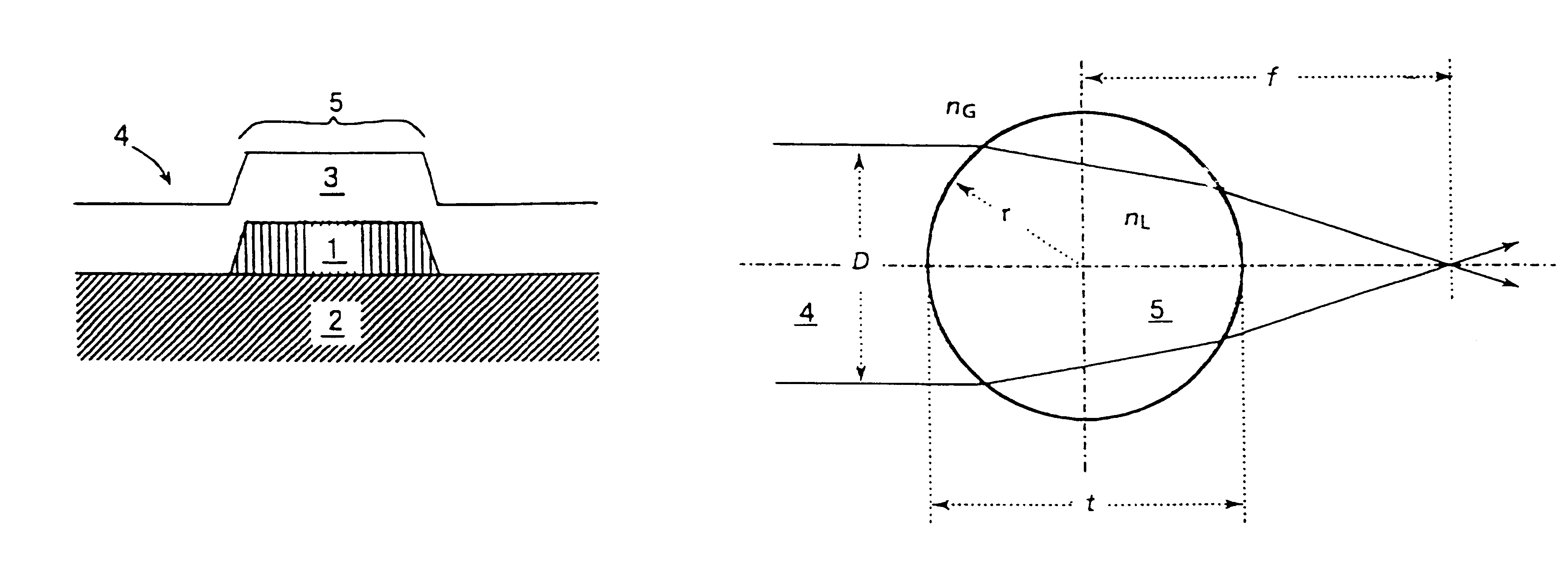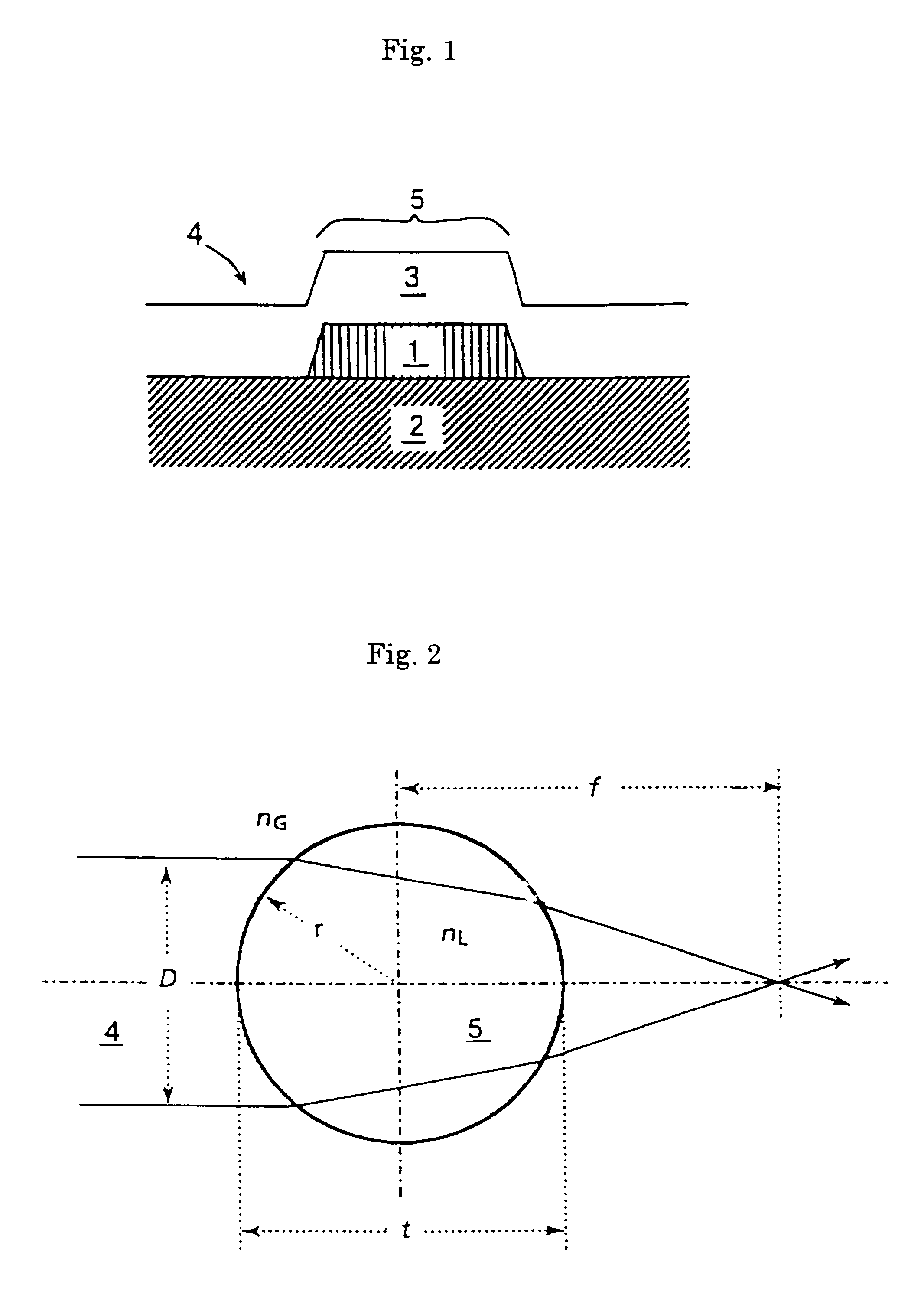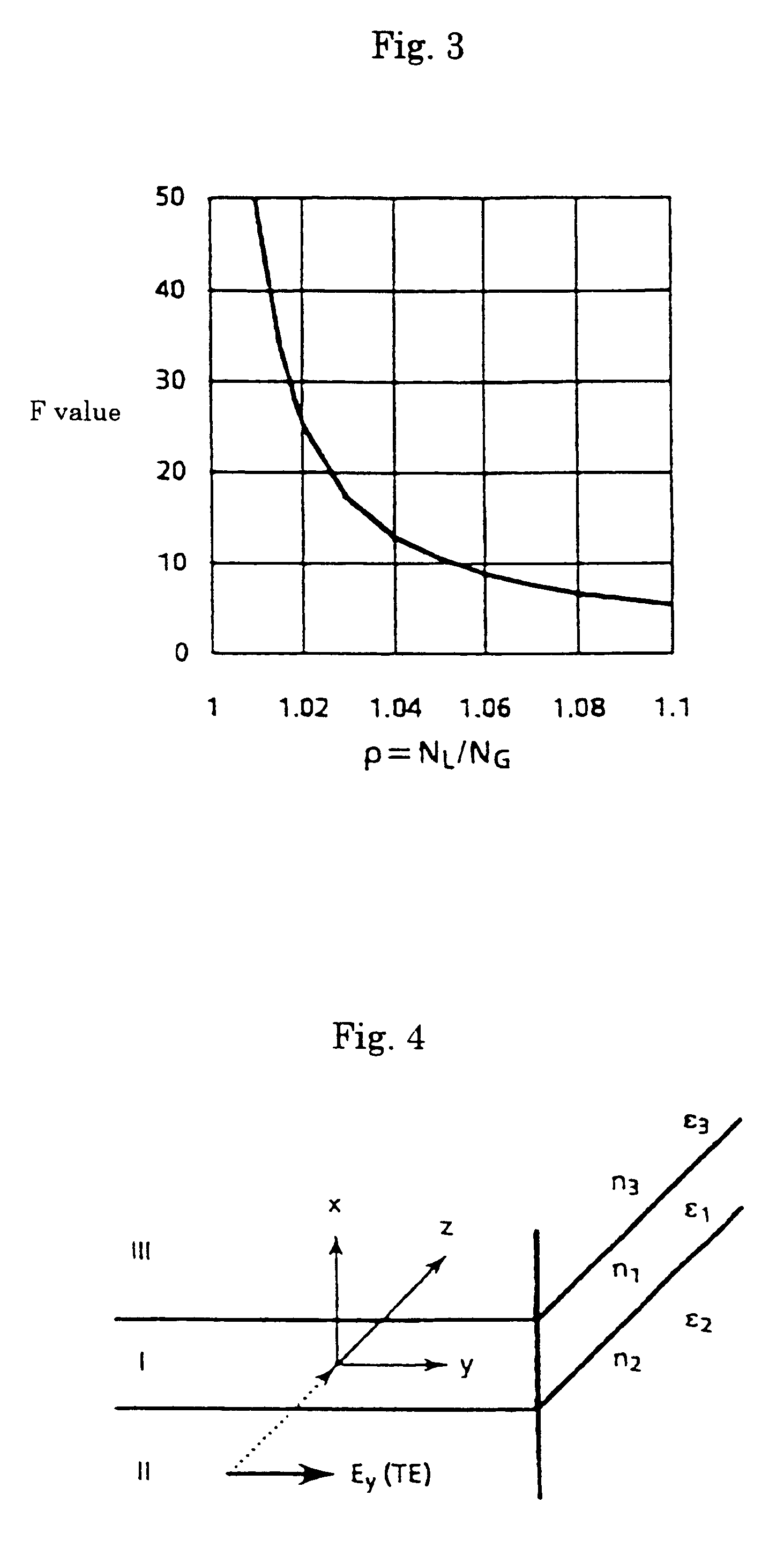Optical waveguide device and manufacturing method thereof
a technology of optical waveguides and manufacturing methods, applied in the direction of optical waveguide light guides, instruments, etc., can solve the problems of inability to manufacture thin film optical waveguides with a quality, inability to conduct diffusion or ion exchange of other elements, and inability to meet the requirements of material materials
- Summary
- Abstract
- Description
- Claims
- Application Information
AI Technical Summary
Benefits of technology
Problems solved by technology
Method used
Image
Examples
example 1
In this example, a circular lens of 800 .mu.m in diameter comprising, as shown in Table 1, a waveguide portion 4 of PLZT (9 / 65 / 35) thin film (film thickness=600 nm, n=2.49) / SrTiO.sub.3 substrate (n=2.40), and a lens portion 5 of PLZT (9 / 65 / 35) thin film (film thickness=600 nm, n=2.49) / PZT (30 / 70) thin film (film thickness=500 nm, n=2.61) / SrTiO.sub.3 substrate (n=2.40) and having a structure as shown in FIG. 1 and FIG. 2 was prepared and, further, a comb Al electrode was formed to the waveguide portion, to manufacture an optical switch based on the principle of an acousto-optic (AO) deflection device as shown in FIG. 10.
At first, anhydrous lead acetate Pb(CH.sub.3 COO).sub.2, zirconium isopropoxide Zr(O-i-C.sub.3 H.sub.7).sub.4 and titanium isopropoxide Ti(O-i-C.sub.3 H.sub.7).sub.4 were dissolved as starting materials in 2-methoxy ethanol and distilled and refluxed to finally obtain a precursor solution for PZT(30 / 70) at 0.6M of Pb concentration. Then, the precursor solution was spi...
example 2
In this example, a pupil type lens having 800 .mu.m of radius of curvature, comprising a waveguide portion 4 of PZT (52 / 48) thin film (film thickness =1000 nm, n=2.56) / SrTiO.sub.3 substrate (n=2.40), and a lens portion 5 of PZT (52 / 48) thin film (film thickness=1000 nm, n=2.56) / PZT (30 / 70) thin film (film thickness=800 nm, n=2.61) / SrTiO.sub.3 substrate (n=2.40) and having a structure as shown in FIG. 1 and FIG. 13 was manufactured.
At first, in the same manner as in Example 1, a precursor solution for PZT (30 / 70) was spin-coated on a cleaned, etched and dried SrTiO).sub.3 (100) single crystal substrate 2. Further, after elevating and keeping the temperature to 300.degree. C. in an O.sub.2 atmosphere, a power source for an electric furnace was tuned off to allow cooling. An epitaxial amorphous PZT(30 / 70) was obtained by repeating the procedures eight times. Then, after spin coating a positive resist and applying prebaking, UV-ray exposure was applied to a portion other than the pupil ...
example 3
In this example, a semi-pupil type lens having a radius of curvature of 800 .mu.m on one side, comprising a waveguide portion 4 of PLZT (9 / 65 / 35) thin film (film thickness=600 nm, n=2.49) / SrTiO.sub.3 substrate (n=2.40), and a lens portion 5 of PLZT (9 / 65 / 35) thin film (film thickness=600 nm, n=2.49) / PZT (30 / 70) thin film (film thickness=600 nm, n=2.61) / SrTiO.sub.3 substrate (n=2.40) and having a structure as shown in FIG. 1 and FIG. 14 was manufactured in the same manner as in Example 1.
At first, an amorphous PZT (30 / 70) thin film was obtained on an SrTiO.sub.3 (100) single crystal substrate 2 by use of a precursor solution for PZT (30 / 70). Then, electron beam exposure was applied to a semi-pupil type lens shape by use of an electron beam negative resist to form a semi-pupil type lens shape resist pattern. After etching the amorphous PZT (30 / 70) thin film with an aqueous HCl solution and peeling the resist, a first epitaxial PZT (30 / 70) thin film 1 of a semi-pupil type lens shape of...
PUM
 Login to View More
Login to View More Abstract
Description
Claims
Application Information
 Login to View More
Login to View More - R&D
- Intellectual Property
- Life Sciences
- Materials
- Tech Scout
- Unparalleled Data Quality
- Higher Quality Content
- 60% Fewer Hallucinations
Browse by: Latest US Patents, China's latest patents, Technical Efficacy Thesaurus, Application Domain, Technology Topic, Popular Technical Reports.
© 2025 PatSnap. All rights reserved.Legal|Privacy policy|Modern Slavery Act Transparency Statement|Sitemap|About US| Contact US: help@patsnap.com



